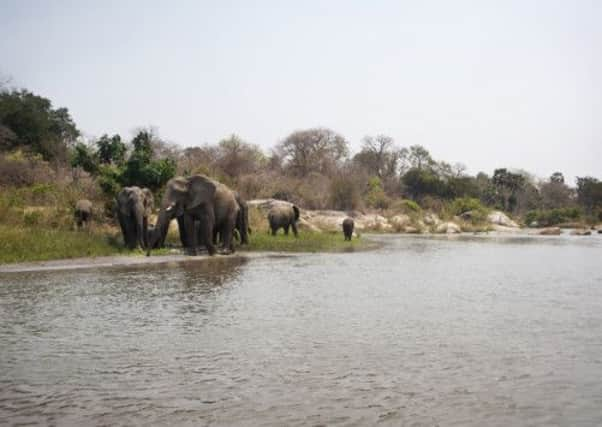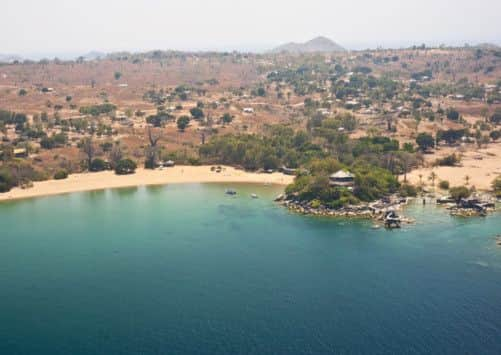A giant’s footsteps


Victorian legend, missionary, explorer – Dr David Livingstone’s African journeys have gained an almost mythical status. He put Lake Nyasa – the third largest lake in Africa – on the map, fought against slavery and it was where he met Stanley in the “Dr Livingstone, I presume?” encounter.
Today, Nyasaland is known as Malawi and I have come to glean a glimpse of Livingstone’s legacy. It begins with his Zambesi Expedition (1858-1864). The Zambesi was to be “God’s Highway” into central Africa. But his plans were scuppered by the Kebrabasa rapids. Instead, he turned his attention to the Shire – pronounced Shiree – which flows from Lake Malawi to the Zambesi.
Advertisement
Hide AdAdvertisement
Hide AdI connect with Livingstone’s route in Majete Wildlife Reserve, which borders the Shire river. Having chugged up the river in a rusty old steamer, the Ma-Robert, Livingstone must have had a dreadful sense of déjà vu. The Kapichira Falls, which he named Murchison’s Cataracts, stopped the boat’s progress. But these falls were to become central to the expedition as a base.


From the Mkulumadzi Lodge, I head out on a game drive with my guide, Chris Kilner, and a game scout. There are elephants and nyala antelopes in the open woodland, but we miss out on seeing the lions. Leaving the vehicle, we clamber over wet rocks to Kapichira where a horseshoe of white water cascades over several metres. From Majete, we drive through the flat lands of the Shire valley. After crossing the river, the road snakes up the Thyolo escarpment, following an old slave route. Perched at the top is Fisherman’s Camp, which works closely with the nearby village of Mbame, where volunteers teach at the primary school. Next to the school is an historic tree where Livingstone camped in 1861.
Chief Binali, a sprightly man, tells me about the history of his village. On Livingstone’s second trip up the Shire, he arrived with Bishop Charles Mackenzie (who was sent by the Universities Mission to Central Africa (UMCA)). On meeting a slave train, the slave traders ran away, leaving 84 shackled slaves behind. Fearful to return home, the freed slaves joined the expedition. This incident fuelled Livingstone’s passion to end the slave trade.
A 20-minute drive takes us to Blantyre, Malawi’s commercial hub. Named after Livingstone’s birthplace, it was founded by the Church of Scotland Mission after his death. In the bi-centenary of his birth, Livingstone’s memory lives on: Livingstone Street, Livingstone Towers, Mandala House, with its Livingstone library and the magnificent St Michael and All Angels Church. Complete with flying buttresses, it was built from handmade bricks.
Advertisement
Hide AdAdvertisement
Hide AdThe next stop is Zomba, the former administrative capital. On the way we take a little detour on a bumpy track, passing cultivated smallholdings and mud-brick houses, to Magomero. This was the site of Malawi’s first Christian Mission, set up by Mackenzie. A few miles further on is Chikanzi village. Interestingly, the then Archbishop of York, Dr Michael Ramsey, led a pilgrimage there in 1959. The Magomero Cross marks the occasion.
Zomba, with its wide, leafy avenues and faded colonial buildings, is dominated by a high plateau. A steep road winds up through forestry plantations. We pass men carrying timber and boys selling yellow mountain berries. From the top are views to Lake Chilwa and Nawimbe Peak which were visited by Livingstone.
An early start from Sunbird Ku Chawe in the cool of the morning, takes us on a long drive through small villages to Liwonde National Park. At the entrance is an interesting little museum about the park’s flora and fauna. A sandy track leads to views of a flood plain and the Shire river. In the woodland, a herd of buffalo and Sable antelopes rest in the heat of the day.
Mvuu Camp has a prime position overlooking the river. Here, the Shire moves sluggishly, flanked by tall reed beds, sand banks and borassus palms. Wildlife viewing is superb. While game drives are interesting – we saw elephants, greater Kudu and Lilian’s Love Birds – it is the boat rides which are special. Livingstone mentions the Shire’s crocodiles and hippos in his journals. They are here in abundance. The boat gets exceptionally close to the crocodiles – they stare blankly from glassy yellow eyes. Upstream there’s a giant baobab at Mvera, where Livingstone camped.
Advertisement
Hide AdAdvertisement
Hide AdOn its last stretch to the lake, the Shire broadens into Lake Malombe, before narrowing again at Mangochi, a dusty, ramshackle town with numerous bicycles and a Queen Victoria clock tower. Livingstone reached the lake in 1859. It is said he pointed at the lake and asked its name. Lost in translation, the answer came back “Nyasa”, meaning “lake”. So it stuck – Lake Nyasa. Lake Lake.
Returning to the lake in 1861, Livingstone and his party explored the area by boat. At Cape Maclear is a large fishing village. During the day, fish are spread out on low tables to dry, and then transported to markets across the country. We see fisherman paddling dugout canoes. The peninsular is part of Lake Malawi National Park, a UNESCO World Heritage Site. Off the sandy bay and rocky islands I go snorkelling. There’s a magical underwater world: the tiny, vibrant rockfish, mbuna, are prolific.
Livingstone sailed north as far as Nkhata Bay and east to the island of Chizumulu. I follow his route along the shore as far as Nkhotakota. A slave depot in the 19th century, it was run by an infamous Arab called Jumbe. Next to St Anne’s Mission hospital is another tree where Livingstone met with Jumbe and the Chewa chiefs.
It’s a morning’s drive from Nkhotakota to Lilongwe airport. I am booked on the Ulendo Airlink to Likoma island – a 50 minute trip in a Cessna 210.
Advertisement
Hide AdAdvertisement
Hide AdWe are met by Michelle in an open Land Rover. Likoma is small – four miles long, with 13 villages and a population of 9,000. A short drive leads us to Kaya Mawa Lodge, with its enchanting secluded cottages tucked away on a sandy cove. There are plenty of beach activities, from canoeing to diving. But I am still on a Livingstone quest.
Set back from the main village is the UMCA’s St Peter’s Church. After leaving of Magomero, the Mission moved to Zanzibar before settling on Likoma. The church is the largest building on the island. Similar in size to Winchester Cathedral, it has seven altars, a baptism pool and cloisters. The verger, Vincent Phiri, gives me a tour. He points out a small crucifix hanging behind the pulpit. It’s fashioned from a piece of wood taken from the tree under which Livingstone’s heart is buried in Chitambo, Zambia. It seems a fitting tribute to the missionary explorer who played a pivotal role in the Land of the Lake.
Getting there
Claire Foottit travelled to Malawi with The Independent Traveller http://independenttraveller.com, 01628 522 772, www.facebook.com/theindependenttraveller
Kenya Airways operates daily services from Heathrow to Nairobi with daily connections to Lilongwe in Malawi. Economy return from £678.79, including tax. www.kenya-airways.com, tel 0208 283 1818
Advertisement
Hide AdAdvertisement
Hide AdMalawi Tourist Information Office: www.malawitourism.com, 0115 9727250
2013 marks the bicentenary of Livingstone’s birth and a number of events are planned. For information visit: www.davidlivingstone200.org/events